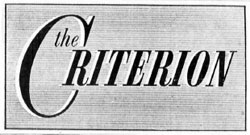What was in the news on April 2, 1965?
Concelebration and Communion under both species, and a reflection on nuns protesting in Selma
 By Brandon A. Evans
By Brandon A. Evans
This week, we continue to examine what was going on in the Church and the world 50 years ago as seen through the pages of The Criterion.
Here are some of the items found in the April 2, 1965, issue of The Criterion:
- Rome issues norms for concelebration, dual Communion
- “VATICAN CITY—Concelebration of the Mass will be allowed in five different situations, and Holy Communion can be given under the forms of both bread and wine in 11 cases, according to a newly issued liturgical book. The new norms are in line with the provisions of the ecumenical council’s Constitution on the Liturgy declaring that concelebration may be approved by the local ordinary at the main Mass in churches when the needs of the faithful do not require that all the priests available should celebrate individually. The Precious Blood may be given to priests, religious or lay people either directly from the chalice, with a reed (such as the golden straw traditionally used in papal Masses), or by dipping a spoon containing the Host into the chalice and then placing it in the communicant’s mouth.”
-
Fireworks erupt over school aid
-
Study still underway: Birth control issue urgent, Pope stresses
-
Cardinal Carberry presses for unity, civil rights
-
Third resident hall set for Latin School
-
Laymen may read Passion
-
Lafayette Diocese gets administrator
-
Many obstacles: Rhythm research progress is slow
-
Optimism for unity voiced by cardinal
-
500 nuns briefed on seamy side of life
-
Cardinal Bea: Sees no crisis over authority versus liberty
-
Editorial: Marching nuns
- “We long have championed Cardinal Suenens and others who have called for an updating of the garb of the sisterhoods. But, at the moment, we are grateful that the modernization remains uncompleted. Where would the Alabama demonstrations have been without the dramatic presence of coif and veil? In the consolidation of religious conscience that evolved at Selma, no other group of marchers had the impact of the nuns. They seemed to represent the ultimate protest, to the marchers, to the segregationists, and to the country as a whole. Catholic clerics and laymen who insist that nuns belong in the relative anonymity of cloister or convent have criticized the presence of these gentle super-pickets at Selma. But the critics are awash in a quiet revolution.”
-
Critics of President unfair on Selma issue
-
Franco’s critic’s transfer is played down by press
-
Yugoslavia passes new religion law
-
Theologian gives different slant on Martin Luther
-
Parents are alarmed at campus ‘morals’
-
Wagga Wagga shows the way
-
Liturgist predicts added Mass changes
-
Religious art center opened
-
Planning secretariat to deal with atheism
-
Notre Dame dean of science named Laetare medalist
-
Marian gets grant to purchase pianos
-
List promotions on the faculty of St. Mary-of-Woods
-
Patriarch tells why he became a cardinal
-
Requiem offered for slain Detroit civil rights worker
-
Vote rights law seen ‘imperative now’
-
Sees U.S.-Vatican diplomatic ties
(Read all of these stories from our April 2, 1965, issue by logging on to our special archives.) †
 By Brandon A. Evans
By Brandon A. Evans